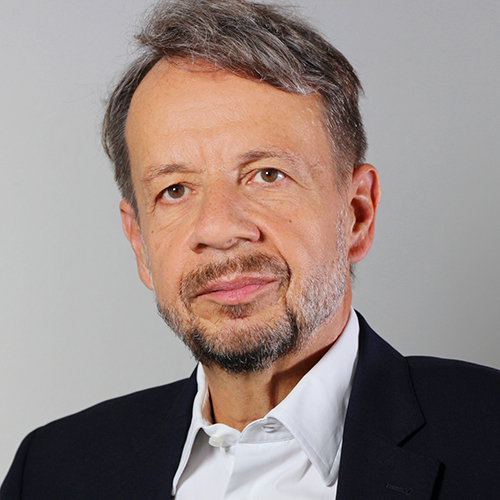Legitimacy is the foundation of media sustainability
Interview with Gilles Marchand, the Former Director- General of SRG SSR, the Swiss Public Service broadcasting, Director of the « Media Philanthropy Initiative » at the University of Geneva and founder of the consultancy firm legitima.
Interview conducted on the October 23rd2025, by Javad Mottaghi, Ph.D, B.Eng.
Professeur associé | Département d’affaires internationales
HEC Montréal
Javad Mottaghi (JM): SBC as the public service broadcaster in Switzerland consists of five units, seven TV channels, 17 radio channels and several digital platforms. With four national languages and a federalist system, how is Switzerland’s main public service media structured? How does federalism work in a media company?
Gilles Marchand (GM): SRG mirrors Switzerland and its political system: decentralized and organized along linguistic areas. We probably share some similarities with CBC/Radio-Canada in terms of structure. We have a national Board of Directors and a CEO who define company policy and strategy in all major sectors. The CEO also manages relations with Parliament and the regulator. Then, there are regional units in the four linguistic regions, each led by a director reporting to the CEO.
There is a high degree of regional autonomy in programming since audiences have different expectations depending on their region. Competition also varies: French-speaking Switzerland competes with French media, while German-speaking Switzerland faces German competitors. Each region has its own media culture.
JM: In 2018, there was a political pressure to cut the license fee that the Swiss citizens pay to the Swiss Broadcasting Corporation – SBC. 72% of the Public voted in favor of license fee and supported the SRG SSR. That means the Public have trust in SBC. But the battle continues even after the existential vote in 2018. SBC Switzerland is once again under political pressure, and its license fee is being questioned. A new vote is coming up in March 2026 to split the SRG SSR budget in two. Why is this happening again? What are their arguments, balance of power, etc.?
GM: It is always the same political party attacking SRG, a conservative, right-wing party. The underlying motivation is largely ideological, particularly in German-speaking Switzerland. This party considers SRG too left-leaning, too inclusive, and too engaged in climate change issues.
In 2018, that party formed an alliance with libertarians who refuse to pay for something they don’t consume entirely. They proposed to abolish the license fee entirely, which would have meant the end of public service broadcasting, especially in a small, multilingual country like Switzerland, where it is impossible to fund a generalist mandate via the market.
They suffered a massive defeat, with over 70% voting against them in 2018. But they learned their lesson. Now, they have returned with a more dangerous threat — not abolition, but a 50% reduction in the license fee, only targeting the public service.
This would not destroy completely SRG but would massively weaken it. And this time, the vote will take place in a more difficult economic context, where many Swiss citizens have less money. That makes it more dangerous. The goal, however, remains the same, and it is political.
JM : One of the most pressing concerns is the erosion of public trust, especially in the face of AI-generated content and the growing threat of disinformation. What role should PSM play in counteracting these risks and restoring trust in media? And what policies and actions would you recommend to help public broadcasters remain relevant in the digital and AI age?
GM: Trust depends on transparency. Transparency in professional practices, as well as in business management. Of course, programming quality that fits the targeted audience, especially the quality of information, are very important: respect for diversity and pursuit of balance. But attitude matters too. For example, public service media should play a constructive role in the media ecosystem and remain open to partnerships with private media outlets.
Regarding AI and digital strategy, I believe PSMs must master new technologies but use them in moderation, especially if it affects/when it comes to their relationship with the public. They must always disclose when AI tools are used. Verification of information and corrections if mistakes are made are essential. I believe that the “human touch” will become a distinctive element, which I find very aligned with the values of public service. We must never risk losing public trust for technological or economic reasons.
JM: In Europe, we are witnessing constant attack on public service media. The five fronts against PSM’s that are systematically present, the counterarguments. I would like to hear your perspective about PSM in Europe.
GM: Yes, I’ve observed this phenomenon across Europe and developed a model that I tested in different countries, in collaboration with the EBU, called the Compass Project.
The model is based on a European benchmark of the main types of attacks on public service media, but also on the Swiss experience/laboratory of direct democracy, where any citizen or stakeholder can trigger a referendum to change the law if they manage to collect 100,000 signatures.
Broadly speaking, in every country where the Compass Project operates, we find the same five fronts, with variations depending on the country:
The ideological front, accusing public broadcasters of being biased, too left-wing, too “woke,” too climate activist, etc.
- The commercial front, claiming PSMs represent a threat to the private market. Either because we are too successful in terms of audience, or because we have commercial revenues.
- The pay-per-view front, that has nothing against us but only wants to pay for content it consumes entirely.
- The populist front, accusing PSMs of mismanaging their businesses, wasting resources, and enjoying privileges.
- Finally, the anti-system front, believing public media are the armed wing of the government and that they manipulate society. This is where we also find the conspiracy theorists.
Across Europe, public service media face all five fronts simultaneously. It’s a difficult situation.
JM: What are the key challenges EBU members are currently facing in this highly competitive environment? And how could these challenges be changed to opportunities?
GM: First, there is massive pressure from powerful international digital competitors, like in Canada. At the same time, audience habits are drastically evolving, especially among young people who consume media “à la carte”, on mobile devices, and individually.
Add to this a funding crisis, as advertising revenue is being captured by international digital platforms. And content is considered free. Today, it’s easier to sell a connection than to sell content. It’s complicated because you must invest in digital technology and data security, while maintaining broadcasting infrastructure.
Finally, there are growing political attacks, often populist, across Europe, as I mentioned earlier. It’s a complex situation but not hopeless, where the solution lies in trust.
In Europe, disinformation and polarization are seen as major threats, yet we see a positive correlation between the level of trust in public media and a lower sense of polarization. In short, democracy works better when public services are strong. Ultimately, everything depends on trust.
JM: What leadership and managerial qualities and skills are essential for a PSM leader in the media industry today to meet the future challenges?
GM: Keep your cool and stay calm, show courage and resilience. Of course, you need a good understanding of the media market dynamics. But you also need high ethical standards and a strong commitment to public value issues. That’s our unique selling point. You need a genuine interest in content and must defend editorial independence. Finally, you must be a skilled communicator – it’s essential. Otherwise, you’ll crash and burn.
JM : I’d like to hear your thoughts on how media organizations can involve citizens in shaping media governance structures that are accountable, transparent, and protect society from undue influence by powerful interests. I am aware that you succeeded in doing so in Switzerland.
GM: It’s a matter of company structure and transparency. Civil society must be represented in the bodies that oversee the media organization. Their role should be advisory but taken seriously. That’s how SRG operates in Switzerland. In each region, we have councils representing the public, to whom we report. They don’t make decisions, but we must listen. This allows us to maintain direct contact with the public and keep our feet on the ground. Transparency means being accountable for everything, and regularly discussing with citizens what they like or dislike about our programs.
JM: In our previous conversations with the media CEOs, we talked about the governance and performance of media organization. In legitima, you have referred to an important dimension that an organization’s survival and ability to transform is not based solely on governance or performance but on its capacity to face paradoxes and maintain coherent legitimacy. I agree with you and wish to elaborate a bit more on legitimacy of media organizations.
You rightly referred to the fact that in societies fractured by normative complexity, political instability, and institutional distrust, legitimacy has become a scarce and intangible, yet essential resource.
What is your definition of legitimacy for PSM? And why has legitimacy become a scarce but essential resource in modern societies and what makes legitimacy « intangible and crucial »?
GM: I should begin by saying that I have a special connection with HEC Montréal on this topic. The consulting firm legitima was created after discussions with my son Hugo, who studied at HEC Montréal. He completed a master’s degree in strategy, focusing on legitimacy, under Professor Charlotte Cloutier. And Hugo attended and Hugo attended Mr. Fralich’s classes, back in 2019.
Legitimacy is what allows an organization to be accepted and recognized by society, even if we disagree with what it does. More precisely, legitimacy is the collective perception that an organization has the right to exist, act, and occupy space, because it aligns with the values, expectations, and norms of its environment (Suchman, 1995).
In today’s fragmented and unstable societies, performance alone is no longer enough. What matters is whether stakeholders accept your right to act. That’s what makes legitimacy both intangible and essential. For PSM, legitimacy is grounded in public values, supporting pluralism and fulfilling democratic purpose. The 2018 “No Billag” vote in Switzerland was a clear demonstration of that: 72% of citizens reaffirmed SRG’s legitimacy, beyond metrics or market logic.
JM: Is legitimacy the same as reputation? Can an organization have a strong reputation but lack legitimacy? Can you explain the differences and give an example?
GM: Reputation is about image. It’s more, emotional and depends on media trends. It’s more about communications. Legitimacy goes deeper: it’s about acceptability – whether stakeholders believe you have a rightful place in society.
Reputation reflects how you are seen; legitimacy reflects whether society acknowledges your role. An organization can enjoy high visibility and a good reputation, and yet lack legitimacy. For example, in 2026, SRG is going to face a new referendum: its reputation remains high as trust levels are strong, but its legitimacy is again being questioned, both politically and financially.
JM: You have correctly mentioned that organizations are no longer judged solely on what they do (their output or performance) but also on what they represent and their values, ethics, etc. How has the basis for judging media organizations changed in recent times and what values a media organization must demonstrate beyond its performance?
GM: For a media organization today, its’ not just about what we produce, but it’s about what we represent. Media organizations must demonstrate independence, ethical responsibility, and a contribution to society. It’s no longer enough to deliver “good journalism or programs” or high ratings. What matters is being perceived as fair, necessary and aligned with democratic/or political expectations.
JM: I imagine that the three dimensions of legitimacy (systemic, societal and personal) would have impact on each other meaning a weakness in one dimension can affect the others. I also understand that different dimensions of legitimacy require different legitimation strategies. Am I right? Can you give an example of an organization with strong systemic legitimacy but weak societal legitimacy? And why is it important for an organization to address all three dimensions of legitimacy, not just one?
GM: Well, you’re right. As you said, at legitima, we work with a three-dimensional model of legitimacy:
– The systemic (or cognitive) level refers to what is taken for granted in the social fabric.
– The societal (or moral) level concerns actions that are considered fair and normatively appropriate.
– The personal (pragmatic) level relates to the direct benefits experienced by stakeholders or individuals.
All three levels impact one another.
A public broadcaster may enjoy systemic legitimacy, meaning its existence is not questioned, but faces challenges on its societal legitimacy – for instance, if it’s being accused of political bias or not matching social values.
Conversely, a public media outlet may have strong legitimacy on a personal level, for example by offering sports or entertainment that people enjoy, but lose systemic legitimacy if the public starts questioning whether the role of a PMS is to offer that kind of content that private media can provide.
JM: How to align the organization’s positioning to the context without losing direction and how to respond to contradictory institutional demands?
GM: By developing a clear and coherent narrative. For PMS, in a more and more fragmented market, this means focusing on democratic impact more than on audiences and rating. It’s also by admitting that contradictions, such as innovation versus stability, are not anomalies or discrepancies, but part of the new normal.
This means not reacting emotionally to every external pressure and instead responding over the long term. The key question is: are we still aligned with the public values and needs that justify our existence?
Strategic alignment does not mean dilution, following the last trend, but rather remaining focused on the goal, while adapting the right narrative to match the context. In practice, this requires regular stakeholder mapping, perception audits, and strong leadership.
JM: What narratives ensures long-term continuity?
GM: A narrative that links mission and values (identity), with societal benefit (pragmatic legitimacy), moral alignment (normative legitimacy), and institutional necessity (cognitive legitimacy). It must be coherent over time, resilient in crisis, and flexible without losing integrity.
For SRG, during referendum campaigns, the narrative is not only about defending content or jobs. It’s about reaffirming the democratic role of an independent, multilingual media in a federal society.
JM: In your approach, you have rightly mentioned that legitimacy cannot be proclaimed, it must be built and sustained. I agree with you. But one may ask why and why not? And what does it mean to « build and sustain » legitimacy?
GM: Legitimacy cannot be proclaimed – it must be earned. That means listening (mapping expectations), acting (by adjusting discourse and practices), and explaining (through strategic storytelling). Building legitimacy means anticipating shifts in public values; sustaining it means continuously readapting, especially in sensitive sectors like media, health or energy.
JM: What responsibilities must media organizations balance to maintain legitimacy, and what does “normative expectations” refer to in this context?
GM: Normative expectations are the unwritten rules set by society, regulators, and civil stakeholders. These are the practices and behaviors that society considers acceptable. They are not written laws.
Media organizations constantly navigate between independence and accountability, innovation and stability, pluralism and cohesion.
JM: How does legitimacy affect decision – making within media organizations?
GM: Legitimacy creates political and social space for decision-making and strategy.
When decisions are perceived as legitimate, they face less resistance. Without legitimacy, even technical decisions can be contested, on symbolic or ethical reasons. This may be the case with changing broadcast standards, such as a transition to DAB, may trigger controversy if not perceived as legitimate.
JM: Why is legitimacy described as « intangible »? What kind of asset is legitimacy considered to be?
GM: Legitimacy is not a quantitative KPI. It is an invisible but fundamental social perception. It is an important asset for an organization. It takes years to build, and moments to lose.
JM: When can legitimacy be earned and how is legitimacy accumulated over time?
GM: Legitimacy is earned through consistent alignment between purpose, actions and societal expectations. It accumulates through long-term strategy, transparency and consistency. It is tested in moments of tension or contradiction, such as a referendum challenging public service media.
JM: Why is legitimacy important for private entities too (not just NGO’s our public Institution)?
GM: Any organization exposed to public scrutiny, political scrutiny or media scrutiny operates under normative evaluation and societal perception.
In regulated or sensitive sectors, such as media, health, insurance, finance, sports, legitimacy is not optional — it’s a condition for continuity.
JM: Why is acceptability more important than visibility for a media organization?
GM: Visibility attracts attention, but acceptability earns trust. Legitimacy becomes a strategic umbrella: it protects continuity, enables reform, and helps organizations overcome political and social turbulence.
For PSMs, being seen or having high ratings is not enough: what matters is being recognized as legitimate by citizens, political stakeholders, and civil society. Without acceptability, visibility can even backfire, triggering criticism and polarization.
JM: Last question… You led major public and cultural institutions for over two decades. You faced with political, social, and economic pressure during your responsibilities. I understand that in your views, the capacity of media organizations to face paradoxes and maintain coherent legitimacy is more important than governance or performance for an organization’s survival and transformation.
I would like to hear your comments on this matter.
GM: Legitimacy is more important than quantitative performance.
In today’s digital, standardized society, public services must offer a different experience.
Professionalism and rigor are essential, of course. But we also need empathy, we need to claim the right to make mistakes. We need that human touch. We must show that we are not machines and that our intelligence is not artificial.





Laisser un commentaire